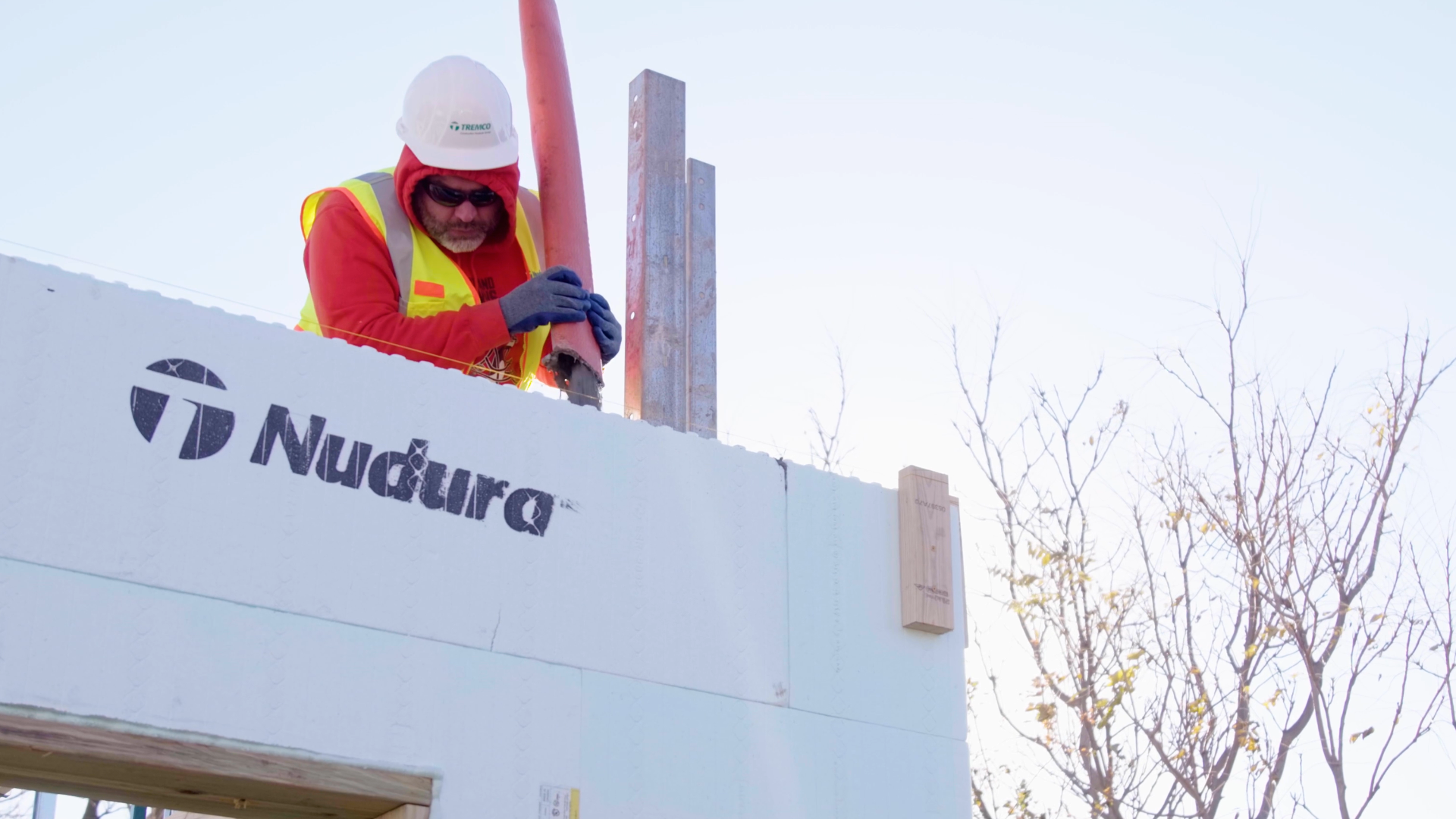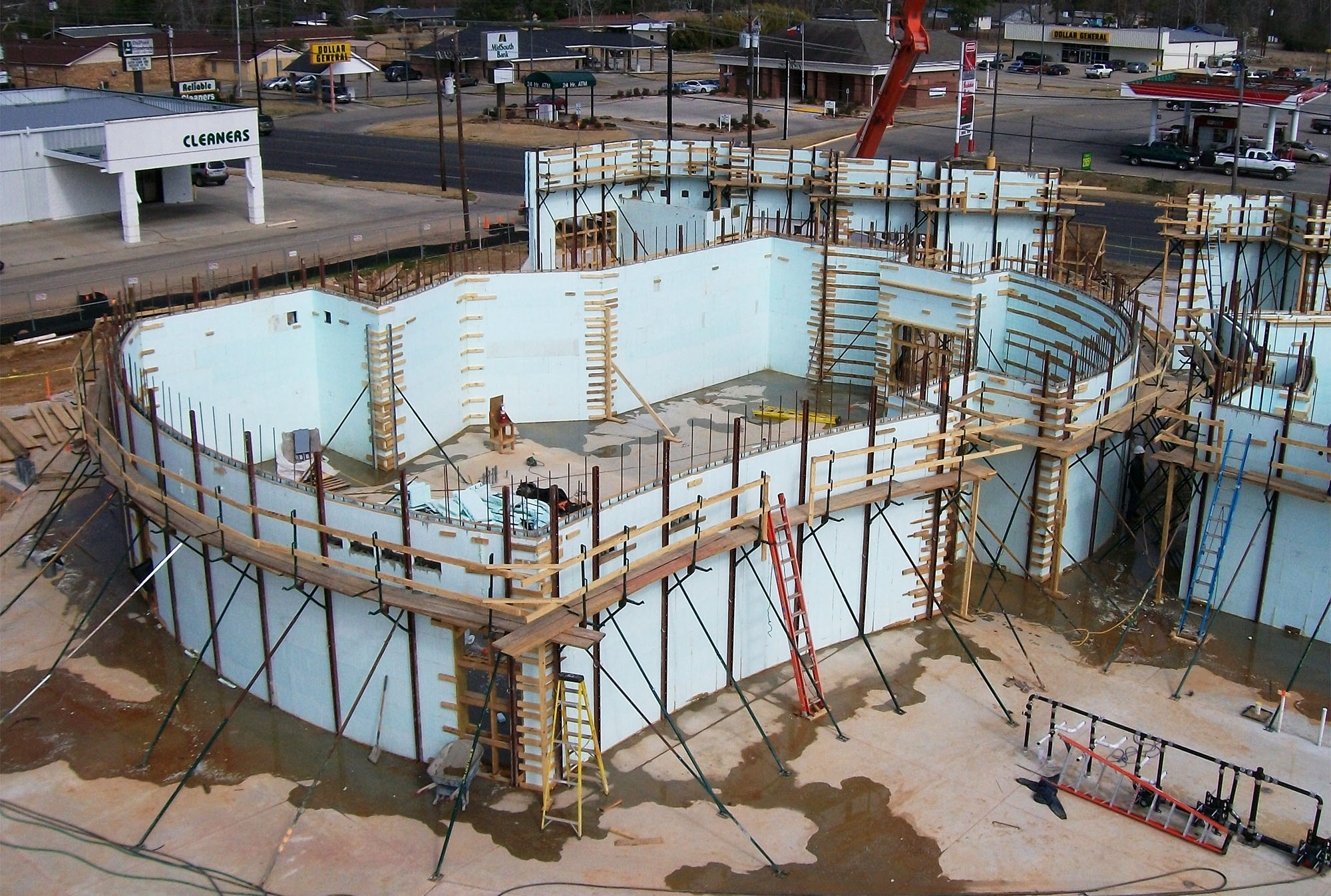
- Products
- Why Nudura
- Nudura Project Applications
- Training Academy
- Resources
- Company
When deciding between using insulated concrete forms (ICFs) and concrete masonry units (CMU) for exterior wall construction, contractors and builders should know the differences between ICF wall systems and their benefits compared to CMUs or cinder blocks. While many design and construction professionals familiar with CMUs may hesitate to consider ICFs due to fear that it complicates the process or increases costs, once they try ICFs, they quickly realize its ease and affordability and opt to use it again for future projects.
While many design and construction professionals familiar with CMUs may hesitate to consider ICFs due to fear that it complicates the process or increases costs, once they try ICFs, they quickly realize its ease and affordability and opt to use it again for future projects.
Here are the five main advantages of building with ICFs over cinder blocks:
- Increased strength
- Improved energy efficiency
- Decreased costs and maintenance
- Efficient installation
- Greater design flexibility
1. Strength of ICFs over Cinder Blocks
Building ICF walls involves stacking interconnected hollow EPS (expanded polystyrene) foam blocks. These forms lock into place and help to create continuous insulation on the interior and exterior of the building from the foundation to the roof. After reinforcing and bracing the insulated concrete forms, skilled professionals pour concrete into the cavities. This poured-in-place concrete wall system creates an solid, seamless structural support enhancing the building's strength and durability over CMU construction.
CMUs construction involves laying concrete cinder blocks and securing them together with mortar. For added strength, you can fill the cells with concrete, placing rebar in every three or four cores. However, this does not create a continuous concrete system like ICF walls. Therefore, cinder block buildings do not have the same strength or integrity as ICF structures.
Wind-Resistant ICFs
Buildings constructed with insulated concrete forms can withstand winds over 200 mph due to the continuous load path. This ensures that when uplift and lateral forces hit a building, the load will travel from the roof, wall and other components toward the foundation and into the ground. Nudura ICFs meet the Federal Emergency Management Agency (FEMA) guidelines for safe rooms in storm zones with winds up to 250 mph.
ICF buildings are frequently sought after in tornado- and hurricane-prone regions due to their wind-resistance. In 2018, the Hurricane Michael hit Mexico Beach, Florida with windspeeds upwards of 160 mph and a storm surge of 9 to 14 feet, but the lone beachfront property to survive the damage was a home constructed with Nudura ICFs. This is just one of several testimonials to prove the tornado-resistant and hurricane-resistant nature of insulated concrete form systems.
Impact-Resistant ICF Walls
Part of the reason that ICFs are used in vulnerable locations is their strength again impact during extreme weather conditions. ICF walls resist damaging debris flying over 100 mph, literally splintering wood beams that try to penetrate it.
The United States military now mandates ICFs for the construction of military buildings and housing to protect occupants from the threat of bullets and bomb blasts. When ICF walls were tested against C4 explosives, only the foam ripped off the ICF, leaving the concrete structure intact.
Impact to an ICF wall can also occur in more mundane instances. For example, when a concrete truck accidentally backed into an ICF structure at a job site, it damaged only the façade — the building’s structure was unharmed.

2. Energy Efficiency of ICFs vs CMUs
The energy-efficiency of ICF structures comes from the built-in two-sides of continuous insulation and thermal mass of ICF systems that make for an air-tight building envelope. This energy conservation can save the end user on operational costs from decreased heating and cooling bills. The R-values for ICFs vary with the kind of insulation and thickness of the foam, but most ICF systems perform at an R-value greater than 23, with Nudura offering solutions that achieve up to R-48
Cinder blocks have an innate R-value anywhere from R-4 to R-14 so additional insulation is needed. Insulating CMU walls involves another step after stacking the cinder blocks: adding foam insulation.
3. Cost and Maintenance of ICF and Cinder Block Construction
Factoring in labor, time, and upfront material prices, the cost of constructing an ICF building is comparable to that of a CMU structure.
With labor shortages and escalating costs, ICF builds saves money during construction because they require fewer workers than CMU projects. CMU walls take five to seven workers to construct. In contrast, ICF walls require only one trained installer with the help of a few laborers. ICF training courses are available regularly to ensure that there are skilled workers who know how to properly brace and reinforce the forms and place the concrete inside.
In addition, ICF's wall assembly combines multiple construction steps into one, including insulation, structure, air barrier, vapor retarder and attachment. The all-in-one system significantly hastens project delivery by reducing the coordination of trades which saves time and money for all parties involved.
To achieve the same durability, energy-efficiency and resiliency of an ICF structure with cinder blocks would require builders to install new components and tack on additional steps to CMU construction. These added processes can increase the build time, overall expenditures, and opportunities for application errors.
In the end, ICFs require less labor and time which leads to significant cost savings.
Minimal Maintenance of ICF Buildings
With their ability to withstand major storms and daily wear and tear, ICF homes and buildings require minimal to no long-term maintenance, saving money and time for the owner.
CMU walls require extensive maintenance because environmental factors can degrade CMUs and allow for water infiltration. Therefore, maintaining the long-term integrity of cinder block houses requires regular inspections and repairs for damaged areas of the walls. In addition, you must inspect the control joints for damage, debris, and intact sealants. Furthermore, the walls need regular cleaning to remove mold and dirt.
4. Ease of ICF Installation vs Cinder Blocks
Light-weight ICFs can be moved easily and walls go up quickly. The ICF blocks stack on top of each other, click into place, and are braced for the concrete pour. From there, skilled workers pour concrete down into the middle of the blocks. The quick installation creates a durable, energy-efficient, disaster-resistant wall that enhances the comfort and health of the occupants. The ease of installing ICFs often prompts first-time ICF builders to use them on later projects.
Unfortunately, a concrete masonry wall takes twice as long to build. Cinder blocks are heavy, which also increases freight costs, so moving them around the jobsite is laborious. For CMU construction, you must bring in additional trades to insulate and protect the walls. Framers are used for furring out the walls and an insulation company would then install the insulation. These processes add several days to the project timeline. A CMU building often requires the installation of an air and moisture barrier, adding another trade and more time before creating an air- and water-tight building envelope.
5. Design Advantages of ICF Construction vs CMU
The strength and flexibility of ICF construction provide endless design options, accommodating virtually any home or building, size and style. You can easily cut and shape ICF into customized designs, like curved walls, custom angles, large openings, long ceiling spans and cathedral ceilings. However, builders find it difficult to accommodate solid CMU pieces to radius designs.
ICFs can also attain any exterior finish for any look desired whereas CMU structures tend to have that iconic cinder block aesthetic.

Why You Should Choose ICF Over CMU Construction
You can build with ICF for the same cost as cinder blocks. However, ICF construction outperforms CMU construction with greater durability, energy-efficiency, reduced maintenance, simplified installation, and superior design versatility. Because of these long-term sustainability and cost benefits, ICFs are increasing in popularity across building sectors.
CONTACT US
We’re committed to supporting homeowners and design professionals who are interested in or use our products. We’re always happy to help and provide more information.





